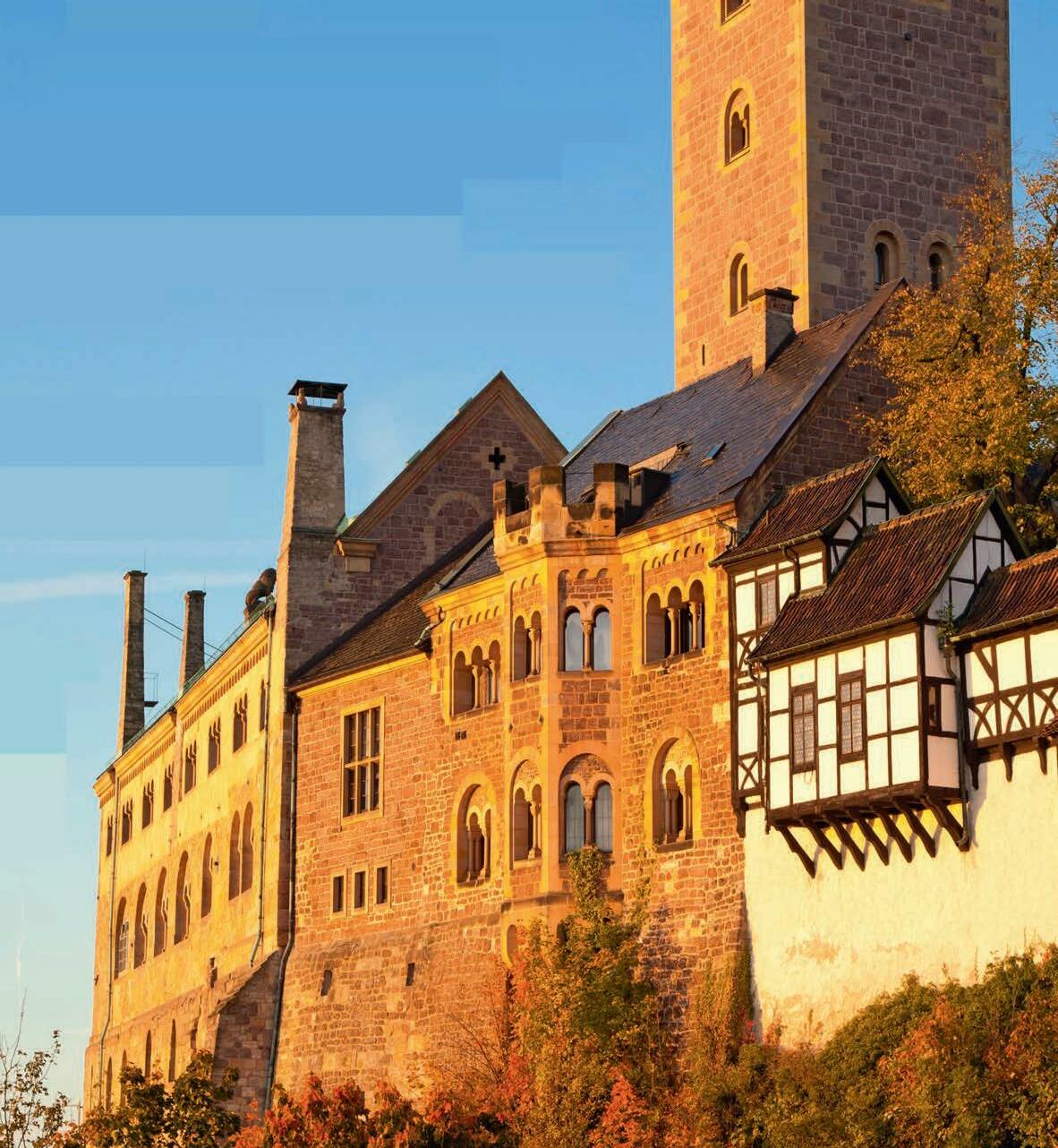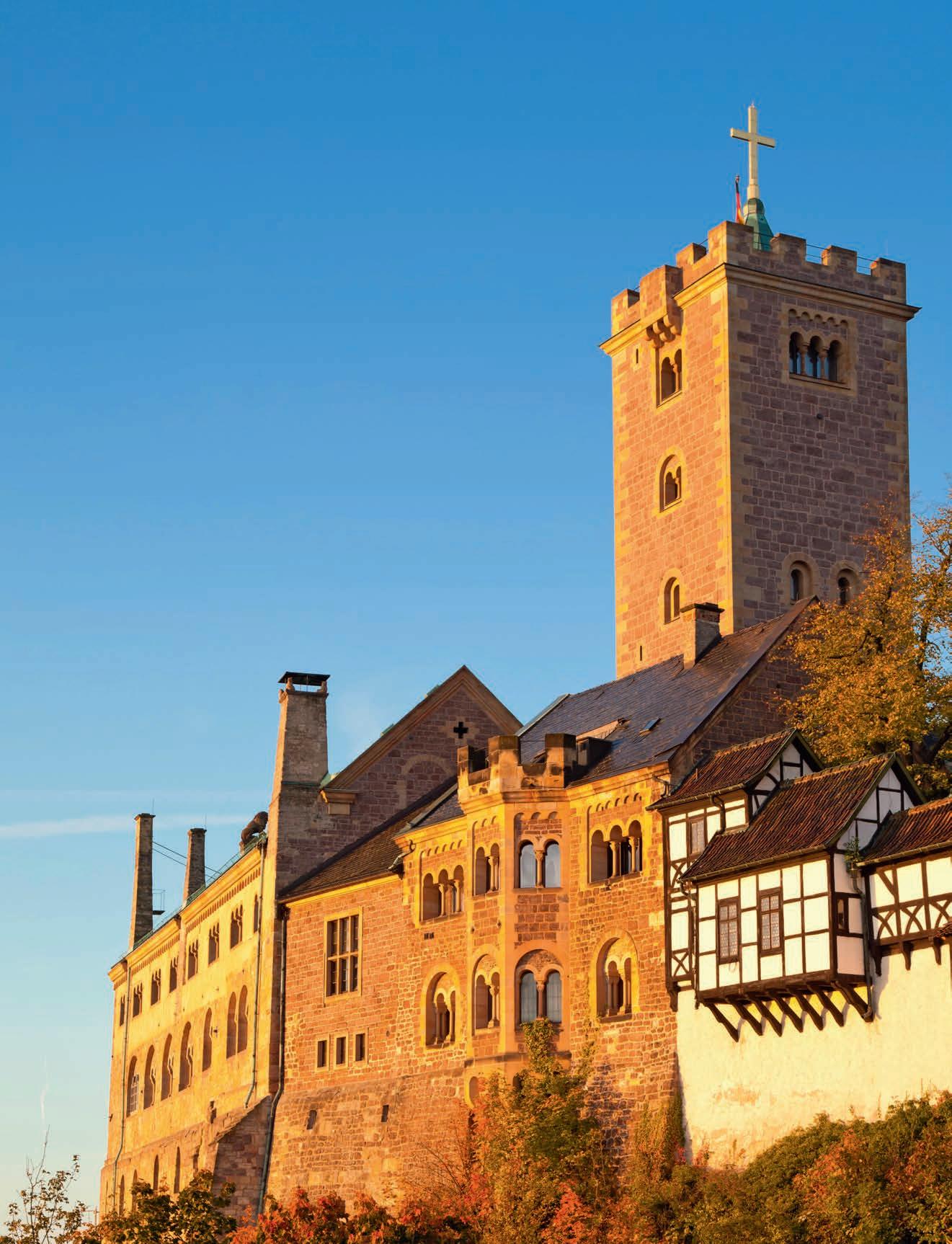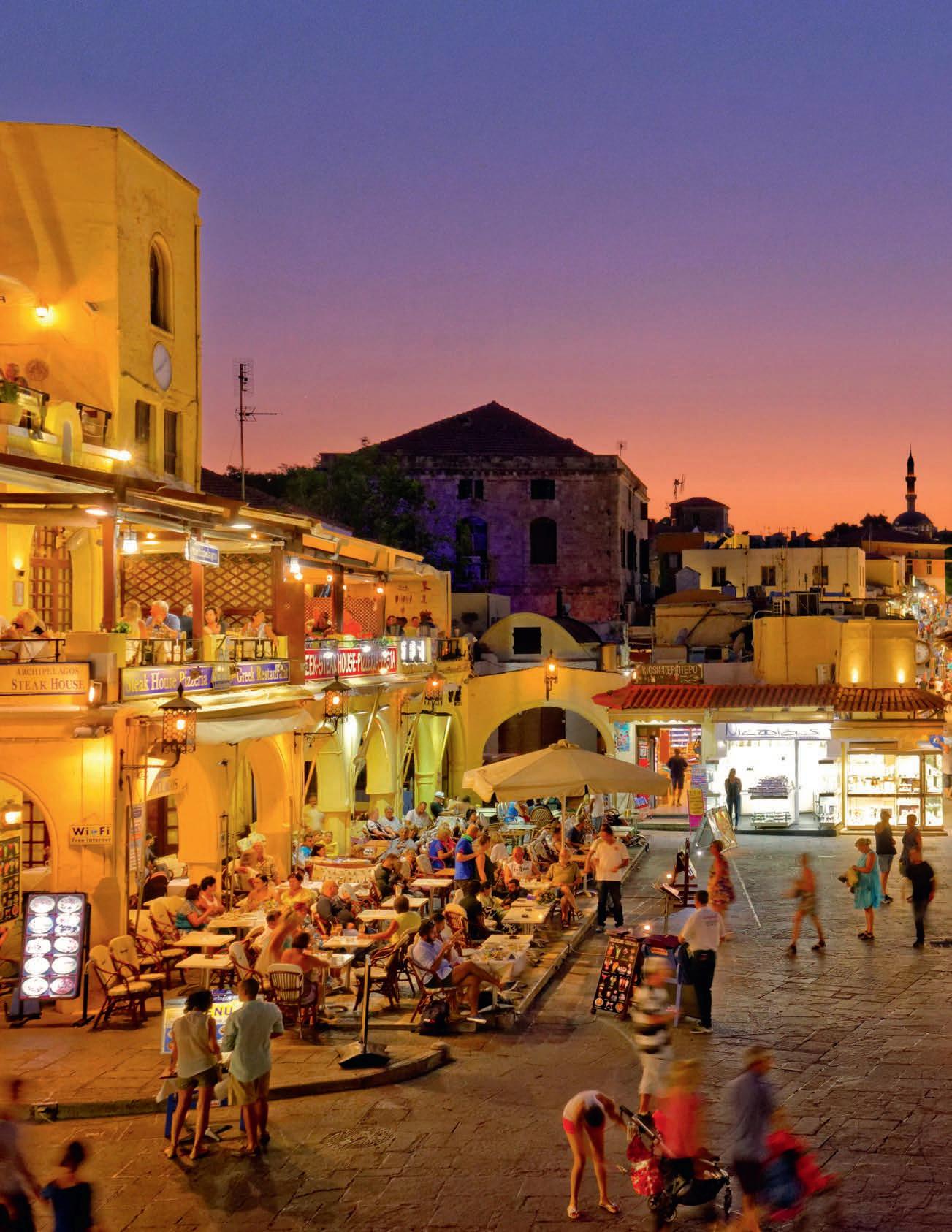
28 minute read
Rhodes
REDISCOVERING RHODES
Boasting thousands of years of important Mediterranean history and culture, we explore the many-layered isle of Helios
Advertisement
Words Juliet Rix
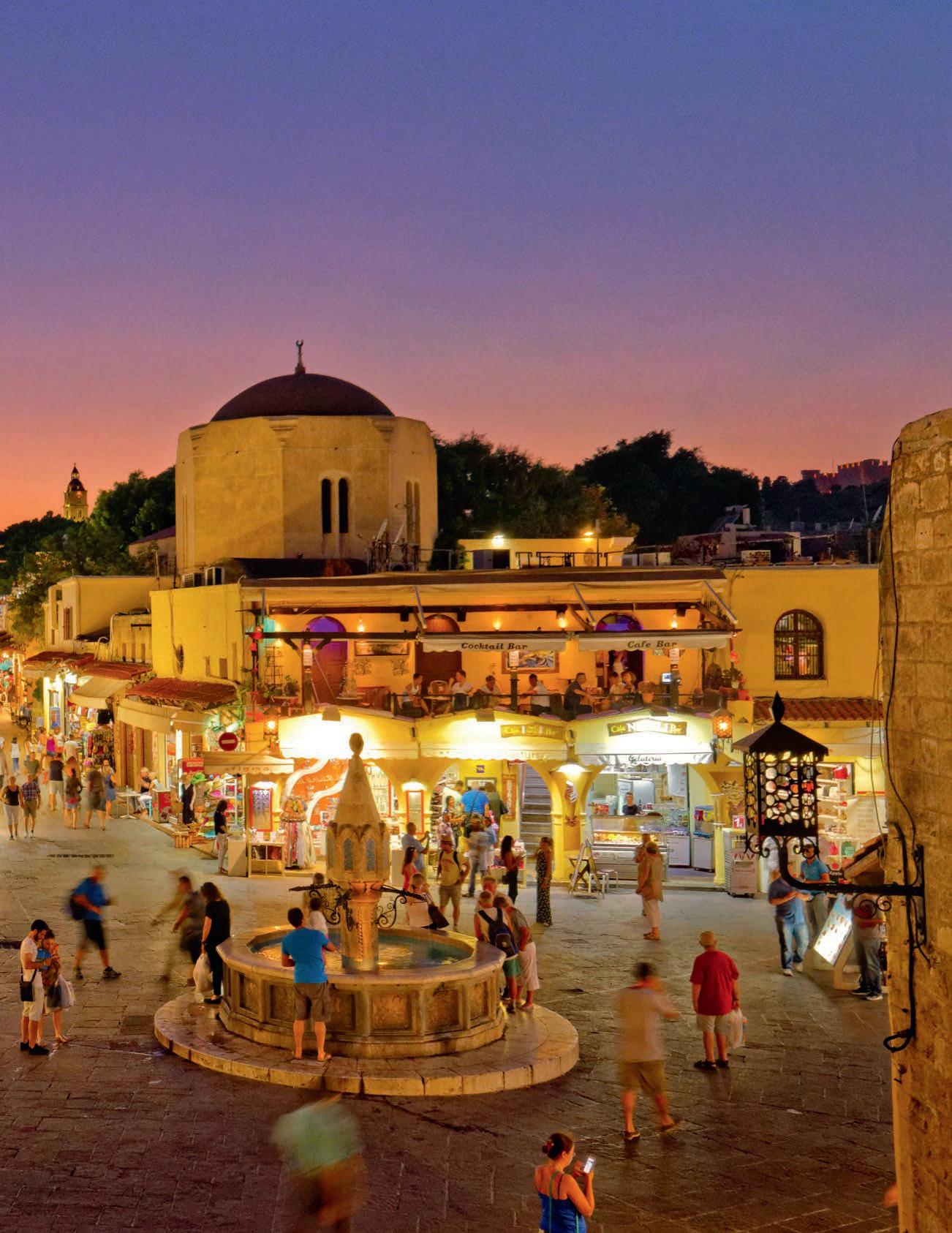
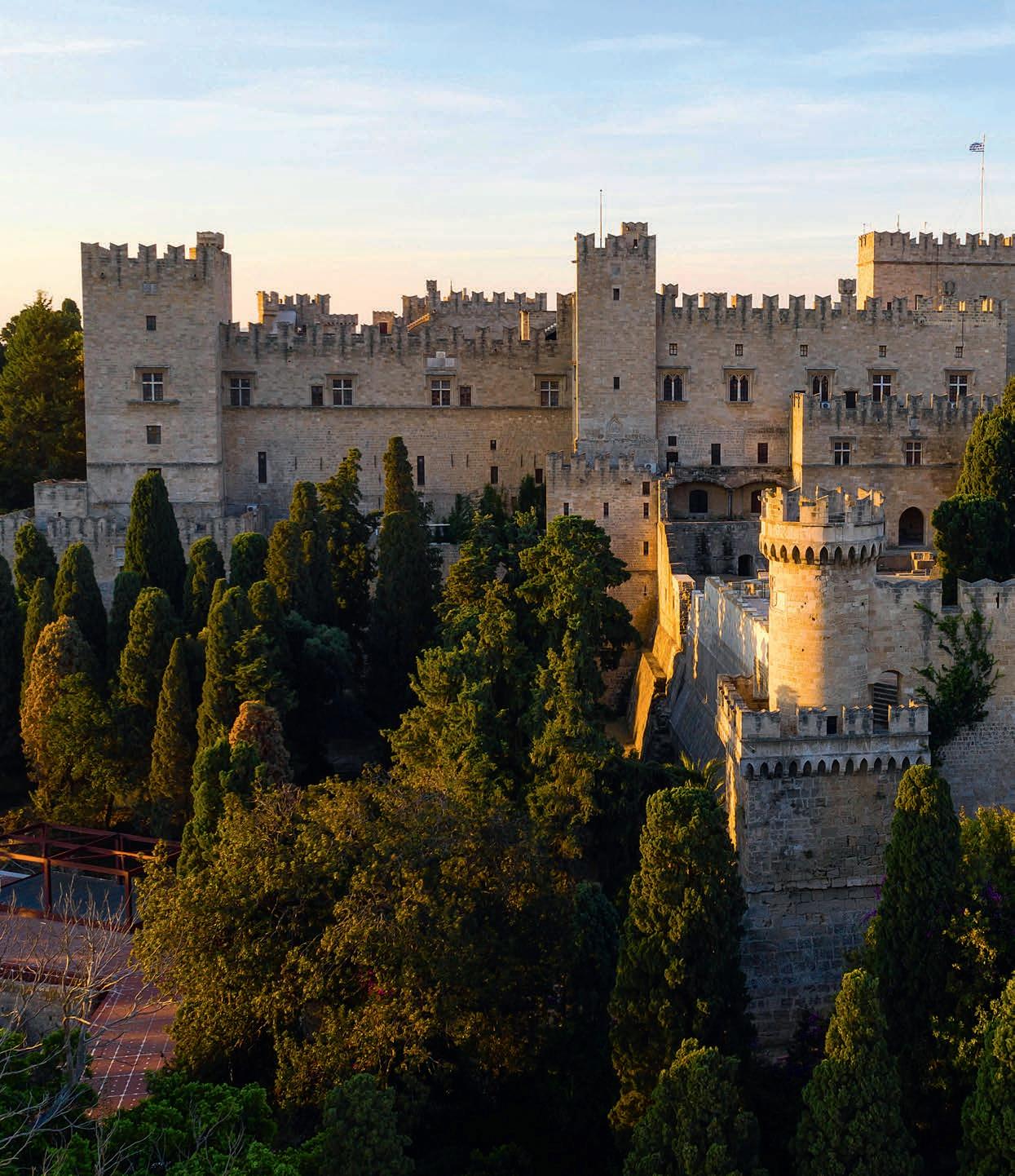
Masterpiece for a Master
The origins of The Palace of the Grand Master of the Knights of Rhodes date all the way back to the 7th century, but its imposing features were added during the extensive renovations in the 14th and 15th centuries; (previous spread) Twilight at Hippocrates Square, Rhodes Old Town When Zeus shared out the earth between the Gods, Helios the sun god was absent. He was left with nothing, until out of the sea rose a beautiful island. Claiming it as his own and naming it after his sea nymph lover Rhodos, Helios has been its protector ever since, or so the story goes.
Certainly, Rhodes is blessed with plenty of sun, as well as emerald seas, golden beaches, whitewashed villages tucked into dramatic rocky landscapes, and many of the other attributes of an ideal Greek island. Rhodes Town however is far from typically Greek, and there are clues all over the island to its unique and variegated history, as layered as a delicious local filo pastry pie.
Rhodes has in fact been ruled by Greeks for less than a third of the last 1,000 years. The Old Town, a UNESCO World Heritage Site, is marked particularly by two pre-20th-century cultures – neither of them Greek – and it passed from one to the other 500 years ago this year. I was going to spend a week exploring the historic sites of this ancient island, hoping that Homer was correct when he described Helios as a god who ‘gives joy to mortals’.
EXPLORING THE OLD TOWN
We arrived at night through St Athanasios Gate, the very same spot where the Ottoman Sultan Suleiman the Magnificent is said to have first entered the city after seizing it in a six-month siege in 1522. He took it from the Knights of St John Hospitaller, the Catholic warrior monks who had ruled Rhodes for more than 200 years. And five centuries later, our zigzag route into the Old Town ran beneath an arch still emblazoned with the Knights’ coat of arms, across a triple bridge over their deep dry moats, and through a tunnel in their bastion walls. Emerging onto a tiny street barely wider than the golf buggy that we and our luggage were travelling in, we zipped along atmospheric alleys between rough stone houses, some more than half a millennium old, and beneath anti-earthquake buttresses creating vaulted passageways with ceilings of starlit sky.
We woke the next day in the heart of the Medieval quarter, looking down into the courtyard of the tiny 13th-century church of St Finourios (or Phinourios), its arched interior boasting Byzantine wall paintings, albeit somewhat damaged by time. The saint is known for helping to find lost things, so I popped in and paid my respects, asking him please to bless our trip pre-emptively so I wouldn’t need to bother him again.
This little church is unusual in being active. Almost all the Old Town’s pre-1522 Christian places of worship were converted into mosques under the Ottomans. While the minarets were removed after the Turks in their turn were displaced by the Italians in 1912, the churches were never re-consecrated and are now ‘monuments’ or museums.
The Ottomans built new mosques too, of course, and just around the corner in Dorieos Square I found the terracotta-domed rear of Agios Finourios almost bumping up against the Retzep Pasha Mosque (built 1588), its elegantly ⊲
carved façade now closed off for restoration. The ritual fountain out in the square, though, is well-preserved, columned, latticed and prettily dappled beneath a giant ficus tree.
The city’s highest point, the top of the 19th-century clock tower (€5, including a drink in the neighbouring café), is the perfect place to get your bearings. I climbed the winding steps to find, spread beneath me, a jigsaw-jumble of roofs and alleyways punctuated by towers and domes alternately topped with crescents and crosses. Neatly encircling it all are powerful fortifications flanked by the sparkling harbours that made this place so desirable to the region’s traders and invaders, from far earlier than either the Knights or the Ottomans.
ON THE TRAIL OF THE KNIGHTS
This citadel city was founded in 408 BC when the island’s three city states, Lindos, Kamiros and Ialysos, joined together as one – and thrived. The walls include many ancient stones, but in the Old Town at least, this period survives most vividly in early descriptions. We learn, for instance, that having seen off a siege in 304-303 BC, the relieved victors gave thanks to their protector by creating one of the Seven Wonders of the World, a shining 32m bronze of Helios – the Colossus of Rhodes.
“It probably did not stand astride the harbour entrance as it’s often depicted,” said our excellent guide, Maria Morava, as we stood alongside the deer-topped columns and the Knights’ St Nicholas fortress that now greet arrivals by sea, “otherwise when it fell in the earthquake of 227 BC it would have fallen into the water. In fact, it was described still lying on the ground 250 years later.
The for tress-like Palace of the Grand Master – now housing impressive Greek, Roman and Byzantine mosaics, mostly from Kos – was certainly claimed by the Ottomans. They remained the administrative heart of the island until its destruction in a gunpowder store explosion in 1856. It was rebuilt – accurately on the outside, not so within – by the Italians who, having taken Rhodes from the Ottomans, were keen to quickly establish their (Christian) legitimacy by laying claim to the island’s pre-Islamic history. Most of the extensive Knights’ city we see today is the result of Italian restoration and rebuilding, although the two are sometimes hard to untangle.
They also built frantically afresh. Between the Old Town walls and Mandraki Harbour we passed a parade of their monumental public buildings. Those from the 1910s and ’20s are in an enjoyable syncretic style – combining architectural elements of classical, Knights-period, Ottoman and modern – while those of the ’30s and early ’40s are typically, belittlingly fascist. Most are still used for their original purpose, including the main post office with its appropriated roundel of Helios above the door.
The Greek God stares across the road at the Church of the Annunciation, an exact Italian replica of the Knights’ early-14th-century Church of St John (the original, by the Grand Master’s Palace, was also destroyed in the explosion). The exterior is plain, even dour, as intended by the military monks, but the interior belongs to the post1947 moder n Greek era and harks back to before the Knights. It is covered in a panoply of Byzantine-style Greek Orthodox paintings. We wandered back through the City Walls, beneath bastions striped with arrow slits, embellished with bougainvillea and little caper bushes sprouting between the bricks. After passing the remains of a third century BC Temple of Aphrodite (patron goddess of sailors) and the cobbled, plain-faced Street of the Knights where they lived in their language groups, we entered an expansive arcaded courtyard. Guarded by a Hellenistic lion that once stood on the ancient city’s acropolis, this is both the most untouched of the Knights’ buildings – their late 15th-century hospital – and today’s Archaeological Museum. Here, where the Knights Hospitaller once tended their patients, we traced the island’s past – and its web of connections spanning Sicily, Egypt, even Cornwall – through pottery, grave goods, votive “We wandered through offerings, ancient inscriptions and sculptures from Rhodes’ ar tistic the City Walls, beneath heyday. “There was a time,” said bastions striped with Morava, “when they were churning out statues so fast that even private arrow slits, embellished individuals had them. Cassius took with bougainvillea and 3,000 statues off to Rome in 43 BC little caper bushes but there were plenty left.” A couple of the most impressive, a crouching sprouting between Aphrodite and a head of Helios, were the bricks” away at a show in Athens but due to be returned in 2022. Most extraordinar y of all the exhibits was a set of bronze-framed monocular lenses used for engraving, each marked with its focal length. I’d have guessed they were 17th century; in fact, they date from the 7th-6th century BC. These little instruments alone testify to the sophistication of the communities on Rhodes at the time of the three ancient city-states. So we headed out of town in search of the remains of these remarkable societies. HEADING SOUTH After a glorious swim at sweeping Tsambika Beach (we wondered why the far end was so popular – turned out it was the nudist beach), we made a brief stop at the dramatic clifftop ruins of the Knights’ Faraklou Castle before arriving at the picture-postcard town of Lindos. A thriving settlement for more than two-and-a-half millennia, the town is cut into the cliffs above beautiful, beach-fringed bays, and topped with a t owe r i n g , n i g h t - l i t , a c r o p o l i s. O c c u p i e d since Neolithic times, this high point was fortified and sanctified by (at least) the Ancient Greeks, Romans, Byzantines, the Knights and the Ottomans. ⊲
Rhodes rooftops
The characteristic white rooftops of Lindos looking towards the acropolis, sitting over 100m above the town and dating back to the 3rd century BC
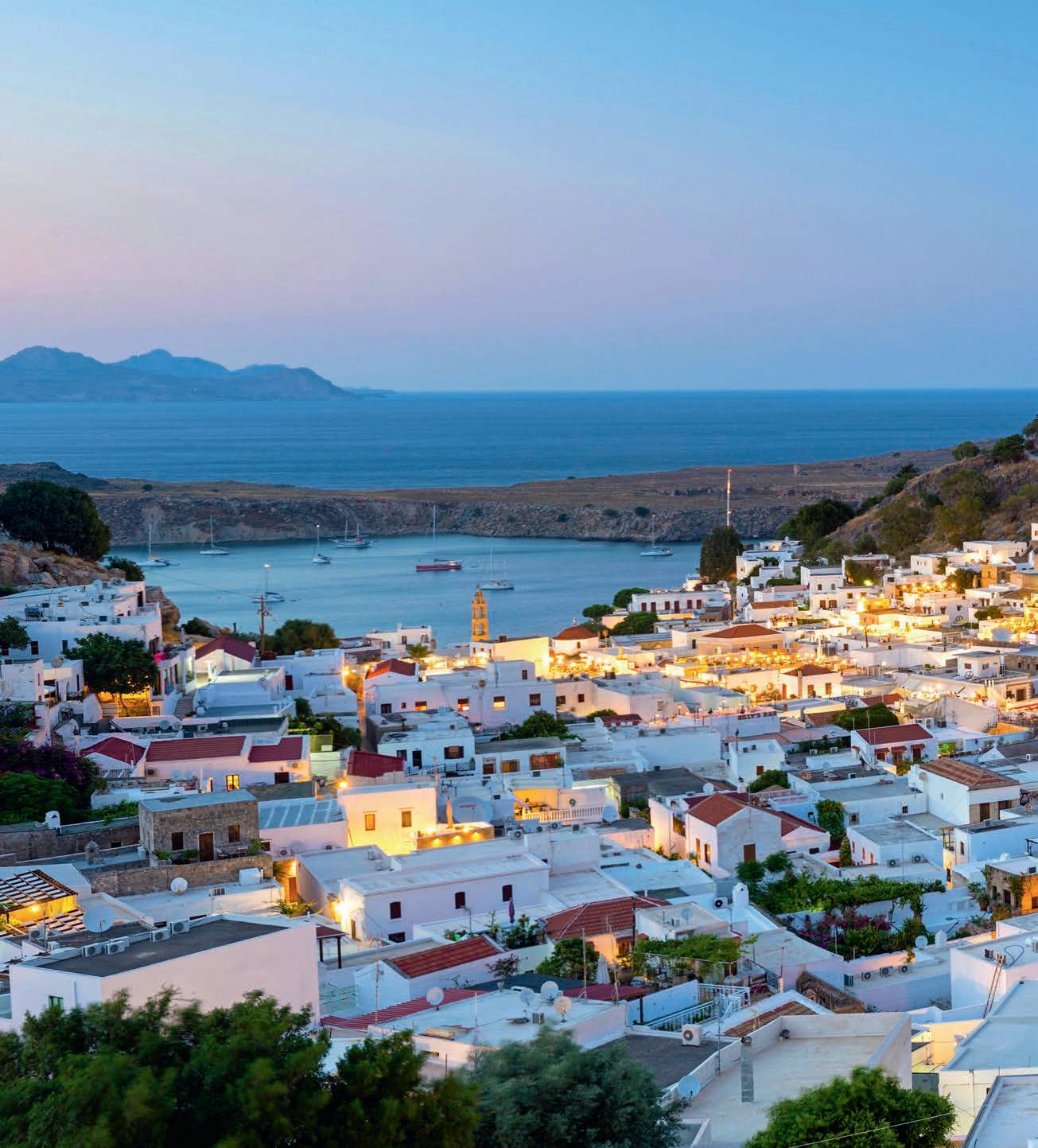
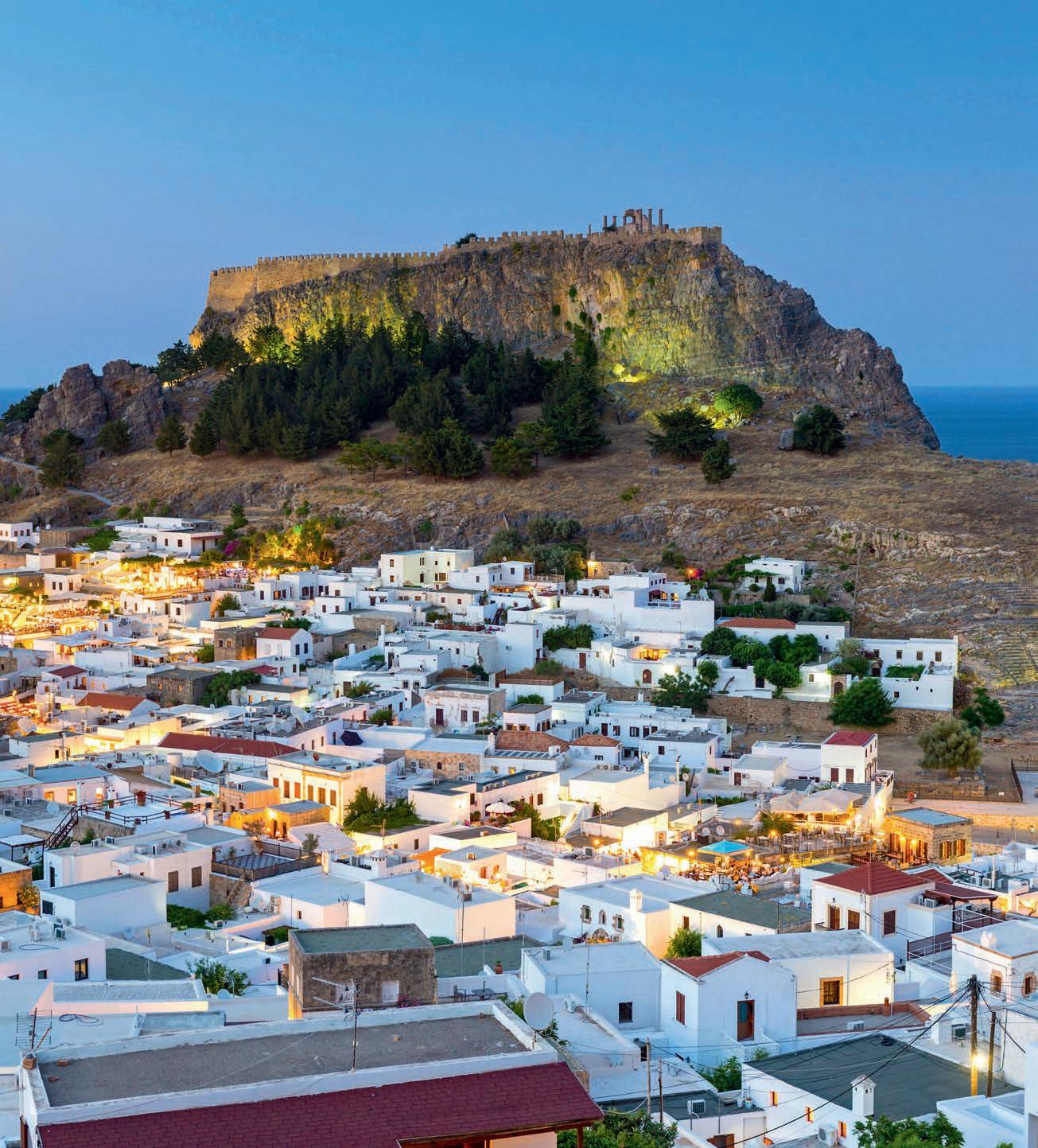
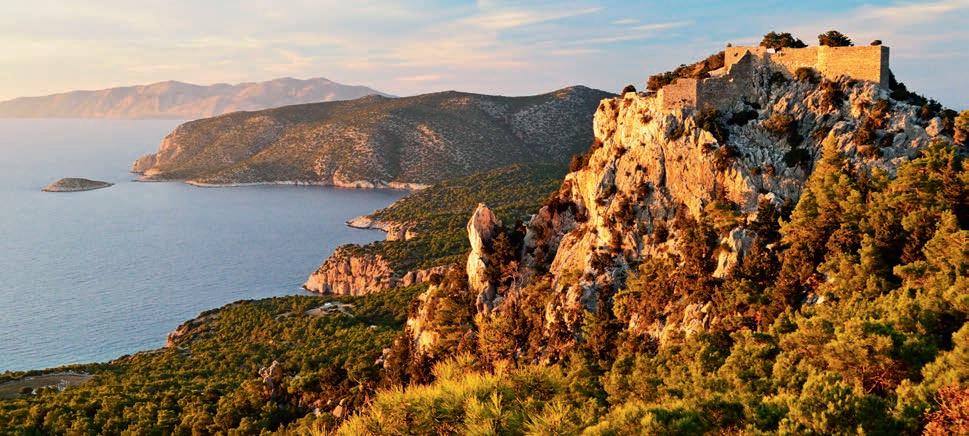
We stayed the night (wishing to see Lindos without 100-metre monolith atop which perches a romantic castle day-trippers) and spent the evening chatting over grappa ruin where we joined a gaggle of tourists gathered for a panoat one of the island’s best restaurants. Wandering the tiny, ramic sunset. By day, it is deserted, but for elegant Eleanora’s pretty pedestrian paths that wind between whitewashed falcons circling overhead. buildings, we spotted characteristic rope-patterned door- It was equally calm at Kamiros, just a little further up frames, legacy of Lindos’s time as a centre of pan-Medi- the coast, as we explored the expansive archaeological terranean maritime trade. This past is celebrated too at the site that displayed all the key elements of the city, rebuilt entrance to the acropolis, where the prow of a near-life-size after the earthquake in 227 BC. From the high acropolis, ship is cut cleanly into the rock. It looks as if it was done last complete with piped water system and 200m stoa, we then century, but dates from 180 BC. descended along streets that swept amphitheatrically down
Passing through Knights’ fortifications and a Hellenis- to the public spaces below – the agora, temples, fountain, tic stoa (arcade) once filled with shops (not unlike those sanctuaries to the gods, a later Roman bathhouse, and of that crowd the lower slopes today), course, an altar to Helios, the protecwe reached the crowning glor y of tor of Rhodes. the acropolis, the Temple of Athena “At the entrance His sun rose strongly off the honeyL i n d i a , c o m p l e t e d a r o u n d t h e 4th centur y BC. Its now-roofless to Lindos’ acropolis, coloured stone so we stopped for a refreshing dip in the sea before Doric columns rose from the rock’s the prow of a near-life- heading on up the coast to complete peak into the clear blue sky. size ship is cut cleanly the trio. The monaster y of Phileri-
None of the trio of city-state sites mos, on the site of a Byzantine castle has much left from their pre-merger into the rock. It looks that sits on the ancient acropolis heydays. But at the souther nmost as if it was done last of Ialysos was an appropriate place tip of Rhodes, past the Cape with its sweeping double beach that links century, but dates to end our many-layered jour ney. Peacocks posed on the stones of Prassonissi island to the mainland at from 180 BC” a Temple of Athena lining the forelow tide, we found the extraordinary cour t of the Gothic-style monassite of seventh-to-sixth-century BC tery built by the Knights of St John. Archaic Vroulia, a short-lived settlement perhaps serving A highly decorated little underg round chapel, once as an intermediate harbour for the cities. We traced a long a knight’s tomb, was re-dedicated to St George, the custoterrace of excavated living quarters tucked against a forti- dian tells me, “perhaps because the next power, the Ottofication wall that rose up the hillside until we reached what mans, did not disapprove of him”. archaeologists have identified as a defensive tower and a Rhodes has seen r ulers come and go for millennia, sanctuary. It’s an evocative site surrounded by azure sea but ask any local and they will tell you that the people and, unlike in busy Lindos, we were quite alone. have always felt “Greek, Greek, Greek”. This is perhaps why, despite the return to rule by Greece and the Greek REMARKABLE RHODES Orthodox Church, they still hold on to the legendary omniAnd so we mostly remained on our final stretch, driving up presence of Helios. As we turned to go, the sun glinted off the west coast, through wild landscapes of sandstone-striped the carved column-tops of the ancient temple and, behind mountains gleaming in the evening sun. This was the case it, lit up the Medieval cross of the Catholic Knights; Helios, until we reached Monolithos, named for the dramatic in his undoubted Greekness, seems to be claiming it all. ⊲
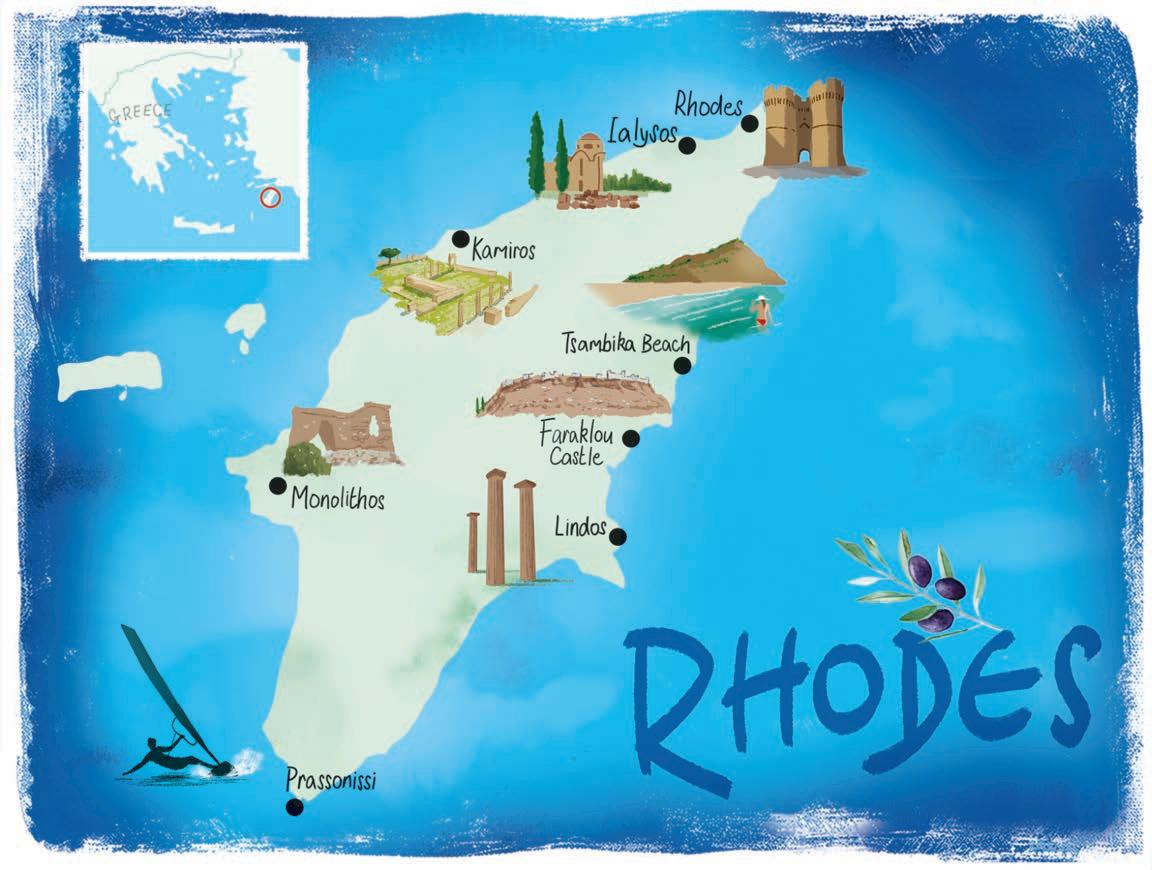
THE TRIP
The author travelled with Sunvil (sunvil.co.uk; 020 8568 4499), who offer a week in Rhodes (B&B) with 5 nights at the 2* Paris Hotel in the heart of the Old Town and 2 nights at Limeri (Monolithos), including international flights and transfers; based on two sharing in mid-May 2022, for £967pp.
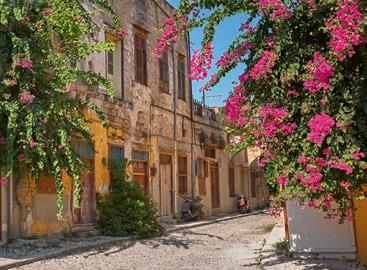
Vital statistics
Capital: Rhodes Town Population: About 115,000 (of whom 50,000 are in Rhodes Town) Language: Greek Time: GMT+2 International Dialling Code: +30 Visas and entry: Rhodes is part of Greece and the EU, so UK visitors have visa-free access for up to 90 days in any 180-day period. At the time of press, visitors will need to fill in a passenger locator form (PLF) and prove full vaccination at least 14 days before travel, recent recovery from COVID-19 or a very recent negative test. Check for the latest details here: www.gov.uk/foreign-travel-advice/greece/ entry-requirements Money: Euro (€), currently €1.2 to the £1.
When to go
The season in Rhodes runs from about Easter to the end of October, after which many hotels and restaurants close. July-August Hot, dry, and crowded. April-June & Sept-Oct Perfect for combining sightseeing with sun and sea. Cheaper than the summer too. Nov-March Very quiet and whatever is open is much cheaper. Weather cooler and less reliable. A time to explore local Rhodes.
Health & safety
General safety in Rhodes is similar to the UK. For the latest information on any booster jabs to consider and health advice, see www. fitfortravel.nhs.uk.
Measures against COVID-19 are generally a bit more stringent. At time of press, you may be required to show a COVID-19 pass as well as wearing a mask to enter indoor public spaces including museums and restaurants. Indoor areas are generally well-ventilated and some areas that cannot be ventilated may be closed. In bars and restaurants you are allowed to remove your mask once seated, or of course, you may prefer to eat outside, which, unless you are unlucky with the weather, is possible for at least three of
the four seasons. See the FCDO site (gov.uk) for the latest information.
Getting there
Multiple airlines offer the four- hour flight to Rhodes from London and regional airports, including British Airways; prices from around £150. Rhodes Diagoras International Airport sits on the north-west coast, a 35-40-minute drive from Rhodes Town.
Taxis and car hire are readily available. Car is the easiest way to travel if going beyond Rhodes Town and Lindos. The author had a car from Butterfly (https:// butterfly-rentacar.eu). Distances are not large and main roads are excellent. Lindos is about an hour’s drive from the capital, the Cape about 1hr45mins. There are also buses and tourist day trips from Rhodes Town.
Cost of travel
Costs are generally lower than in the UK at any given level of comfort – and all levels are available from basic to luxury. Spring and autumn are cheaper than summer. You can eat extremely well without burning too much of a hole in your pocket, especially if you know that starters are often the size of main courses.
Accommodation
There’s plenty of choice and it is easy to avoid the big chain hotels that cluster in Rhodes New Town and along the coast. Simply pick an historic or village location where only small establishments fit onto the tiny alleys.
Paris Hotel (www.paris-hotel-rhodes. gr/en). Rooms are simple 2* but the large garden courtyard is a wonderful oasis of bonsai ficus trees, complete with partcovered al fresco bar/restaurant. Its location in the heart of the medieval city is hard to beat. Owner Paris will collect you and luggage from the nearest Old Town gate. Doubles/twin B&B from about £80.
Melenos, Lindos (www.melenoslindos. com). A beautiful boutique hotel terraced into the hillside between the top of the village and the base of the acropolis. It boasts Ottoman-style décor with huge comfortable platform beds and sea views. Staff will collect you from the car park at the main road. Doubles B&B from £197.
Limeri, Monolithos (www.limeri.gr) An exceptionally good-value 10-room guesthouse in the village, walking distance from the castle. Excellent restaurant servicing rustic local food and a bonanza breakfast. Very comfortable beds too and some rooms with modern wood-burning stoves for cooler weather. There’s an open fire downstairs in winter when the hotel remains open at weekends. Doubles B&B from €69 (£59), €49 (£41) without breakfast.
Food & drink
Rhodes is full of excellent local food at reasonable prices. Best to avoid the touts; really good places rarely need to drag you in.
Auvergne Café & Wine Bar (www. auvergnecafe.gr). At the bottom of the Street of the Knights, the original 15th-century home to the Knights of Auvergne comes complete with a cobbled courtyard shaded by a giant ficus tree. Serves wine from one of the largest lists in Greece, quality coffee and both traditional and international food. For an excellent-value light lunch try the fava-bean paste with soft red onion and crispy Rhodian pitta (€4.50/££4).
To Marouli (www.facebook.com/ tomarouli). This unpretentious vegetarianvegan restaurant in the heart of the Old Town serves modern takes on traditional dishes, including delicious grilled manouri cheese with poached pears and rocket (€8/£6.50), and a good selection of beers.
Mavrikos, Lindos (+30 2244 031232) If you want to push the boat out and try something a bit different, Mavrikos offers Michelin-style unusual twists on traditional recipes. I’d especially recommend the fennel cooked in white wine with feta paste (€13/£11) and a chat with co-owner Michalis Mavrikos if he isn’t too busy.
Meltemi, Rhodes New Town (www. facebook.com/MeltemiRestaurant). At the start of the municipal beach that leads up to the northern tip of the island, with views across the sea to Turkey, this is a beach taverna with very good food – expect a varied menu, all the staples and large portions. The smoked cheese with grilled zucchini (€7.50/£6) is particularly delicious.
Further reading & information
The Blue Guide is excellent for history but is not so up-to-date (last published in 1997).
The Greek National Tourist Office information on Rhodes can be found at www. visitgreece.gr/islands/dodecanese/rhodes.
In Rhodes, the Tourist Information Office just outside the Old Town (3 Averof Street) is very helpful.
RHODES HIGHLIGHTS
1The mysteries of the moat
Between the outer city walls of the Old Town of Rhodes dips the deep, dry moat. Walking around it offers an invader’s eye view that makes it quite clear why this city stood secure for 200 years.
2The Ottoman cemetery
Under-visited and overgrown. Where Ottoman cannons stood to fire on the Knights in 1522, there is now a derelict mosque, a little yellow villa once lived in by Lawrence Durrell and, half-hidden beneath untamed vegetation, a multitude of white-stone tombs, skilfully carved with turbans and fez hats, curlicues and calligraphy.
3A swim beneath the fortifications
A local tip led us to a dip off a tiny patch of beach directly below the fortifications of the Old Town, close to Elaftherias Gate, where clear water lapped at the stony sand.
4Faraklou Castle Originally built by the Byzantines, this fort was the first to fall to the Knights in 1306. There are views along the coast and at the base of the cliff are two natural caves used to hide people and goods during the Second World War (bring a torch).
5Munching melekouni in Monolithos
Melekouni is Rhodes’ traditional energy bar – a mix of sesame seeds and thyme honey, sometimes with added orange or spices. It gives you such a boost that it was considered a form of doping at the Ancient Greek Olympics, with athletes banned from eating it.
WANDERLUST
RECOMMENDS
Greece: Wanderlust Travel Guide – https://www.wanderlust.co.uk/ destinations/Greece/ There’s plenty of video guides around of Rhodes Old Town on youtube.com
Spring into summer
(from left) The UNESCO-listed Great Aletsch Glacier is the longest glacier in the Alps and stretches for 20km; hiking along a bisse (irrigation channel) in Nendaz
BE AT ONE WITH NATURE
With more than 40 mountain peaks over 4,000m, the largest glacier in the Alps and wonderful wildlife, the Valais region’s natural assets are myriad. Start your wild adventure in the glacier-carved plateau that sweeps through the Valais, the Rhone Valley’s sunny plains filled with apricot orchards and vineyards. Don’t miss the incredible UNESCO-listed Great Aletsch Glacier, the longest glacier in the Alps. This 20km river of ice in the eastern corner of the Valais is accessed via cable car from the valley floor – or can be viewed from above on a paragliding flight, if you have a head for heights. The nearby Villa Cassel, built in 1902 as the residency for Sir Ernest Cassel, is now a Pro Natura Centre Aletsch and was the first nature conservation centre in Switzerland. Don’t miss its exhibition about the effects of global warming on the glacier and the efforts being to slow its – ultimately unstoppable – disappearance. Either side of the Rhone Valley, villages cling to the steep mountain slopes, each offering different ways to reconnect with nature. In Leukerbad, for example, you can bathe in natural thermal waters that have been prized since Roman times, while over at Veysonnaz you can practise yoga on a specially designed trail in the Magrappé larch forest.
In the Region Dents du Midi, a collection of six villages in the Val d’Illiez, join a local herbalist and mountain guide for a hike or e-bike tour of the slopes above Champéry. Along the way you’ll stop to pick cumin seeds, wild rhubarb and nettles, which can be used to create a truly organic picnic – listen out for marmots trilling in the background as you tuck in.
For more wildlife spotting, head to the southern Valais village of Saas-Fee where ibex can be seen along the Ibex Trail, a high alpine hiking route starting at the top of the Hannig cable car. Finding one of these shy mountain goats among the rocky scrub or larch forest is reward enough for your exertions on the four-hour walk, even without the view of the glaciers and high peaks of the Mischabel massif from the hike’s highest point, the Mällig at 2,700m.
Easier to spot are Valais’ blacknose sheep, since they’re fitted with GPS trackers. Take the Gornergrat Bahn from the village up to Gornergrat and use your mobile to track down these native Valais sheep, with their shaggy cream fleeces and dark brown faces, who are usually perfectly posed for photos in view of the Matterhorn.
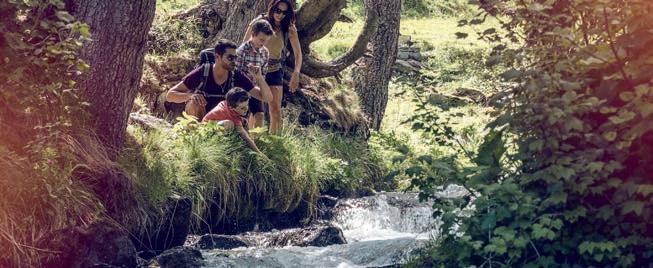
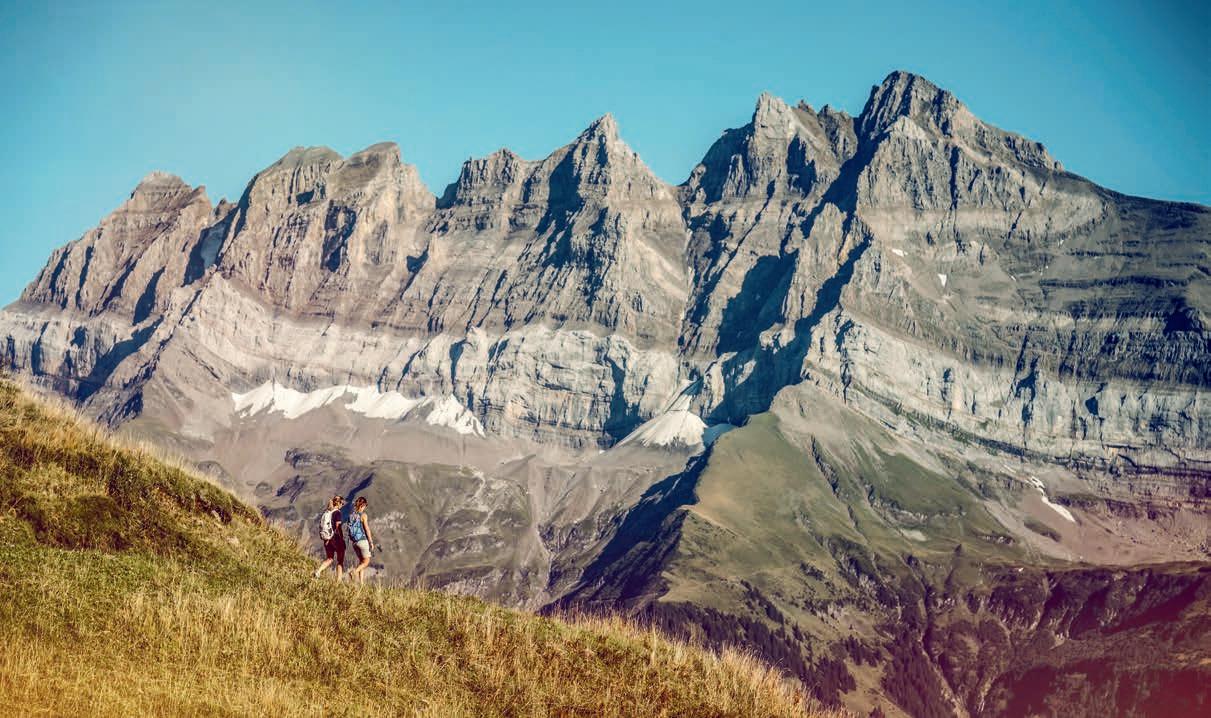
GET HIGH ON HIKING
With more than 8,000 kilometres of signposted hiking trails, the path never seems to run out in the Valais, and the Aletsch Arena is a beautiful place to practise this Swiss national pastime. For an easy but satisfying stroll, take the cable car up to Moosfluh and follow the marked trail to Riederfurka to enjoy views of the the Great Aletsch Glacier. More adventurous hikers may prefer to start at Bettmerhorn and walk down a rocky path towards Roti Chumma for a much closer view of the glacier’s stately sweep of ice.
Another top hike in the Valais is to follow one of the area’s many bisses, ancient irrigation channels built to transport water to farmland, which are now mainly used as easy, fairly flat hiking routes. In the small, car-free mountain resort of Rosswald, follow the water trickling along the Bergwasser bisse, which takes you through a forest, far above the Ganter valley and to the Ganter bridge on the road up to the Simplonpass. Near the top of the trail is the isolated village of Stafel, a collection of old wooden houses now mostly used as holiday homes. With no noise except the chirp of crickets in the summer heat, this is a rare pocket of seclusion in a constantly connected world, and a blissful place to switch off.
Other villages making the most of their bisses are Nendaz and Veysonnaz, located in the heart of the 4 Vallées ski area, which also offers a gastronomic hiking tour called Rando’Miam (loosely translated as Yummy Walk) along the mid-19th century Bisse de Chervé. This now dried up waterway makes for an easy stroll through forest and alpine pastures to Siviez, and both ends of the walk are accessible via cable car.
Along the way, hungry hikers can enjoy a starter, main course and dessert at three different restaurants, including the memorable Les Chottes, a former cow barn that has been transformed into a cosy restaurant; the interior still contains the cauldrons and original storehouse once used for cheesemaking.
Les Chottes is also a welcome stop on the Nendaz Trekking trip, a three-to-four-day hiking tour around Veysonnaz and neighbouring Nendaz. Walking a different trail each day and staying the night in mountain cabins along the way makes for a truly Swiss experience.
Another multi-day trek can be enjoyed further west, around the scenic Val d’Illiez on the 42.5 kilometre Dents du Midi trail.
Peak performance
(from top to bottom) The Valais region is home to more than 8,000km of signposted hiking trails, perfect for summer strolls; walking in the Val d’Illiez in the Region Dents du Midi offers incredible views
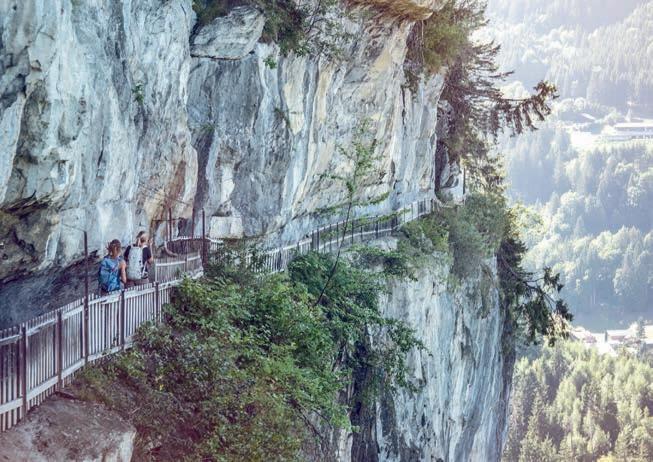
RELAX ON THE RAILS
Switzerland’s scenery looks great from a train and one of the area’s prettiest rides is the Mont Blanc Express which starts at Martigny. It ascends through the Trient valley, passing forests and tunnels, gorges and villages. At Les Marécottes, cool off at the natural outdoor swimming pool, before continuing to Le Châtelard to the VerticAlp Emosson funpark to ride one of the world’s steepest funicular railways. Originally built to transport workmen building a dam in the mountains above, the funicular has been in service for more than 100 years. From the top of the VerticAlp, take a seat in the small-gauge train, before riding the Minifunic lift up to the Emosson dam. This 180m concrete wall supports the turquoise water of the country’s second largest glacial reservoir, and is the start of many hiking trails, including the multi-day Tour du Ruan.
Another fine rail ride is the Gornergrat Bahn. Trains on Europe’s highest open-air cog railway run every 24 minutes from Zermatt up to the viewing platform at 3,089m. Enjoy the view of 29 4,000m peaks, including the Matterhorn and Dufourspitze. For culinary treats along the way, buy the gourmet ticket which allows you to hop on and off the train to enjoy an aperitif at the highest hotel in the Swiss Alps, a three course lunch at the Hotel Riffelhaus on the Riffelberg, and desert at Restaurant Alphitta on the Riffelap. Don’t miss the Zooom exhibition on the Gornergrat, which features a virtual reality paragliding experience of flying over the Matterhorn.
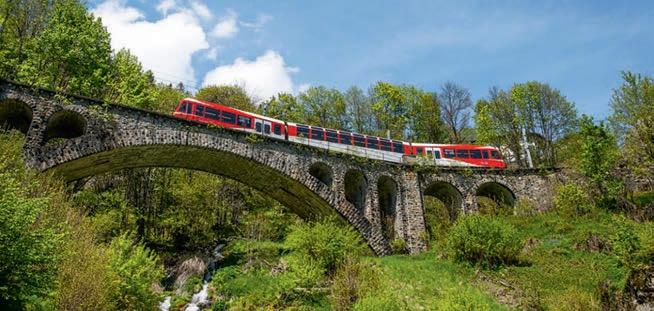
Historic tracks
(top to bottom) The Mont Blanc Express has connected Martigny to Chamonix for over a century; view over SaasGrund from the Triftalp
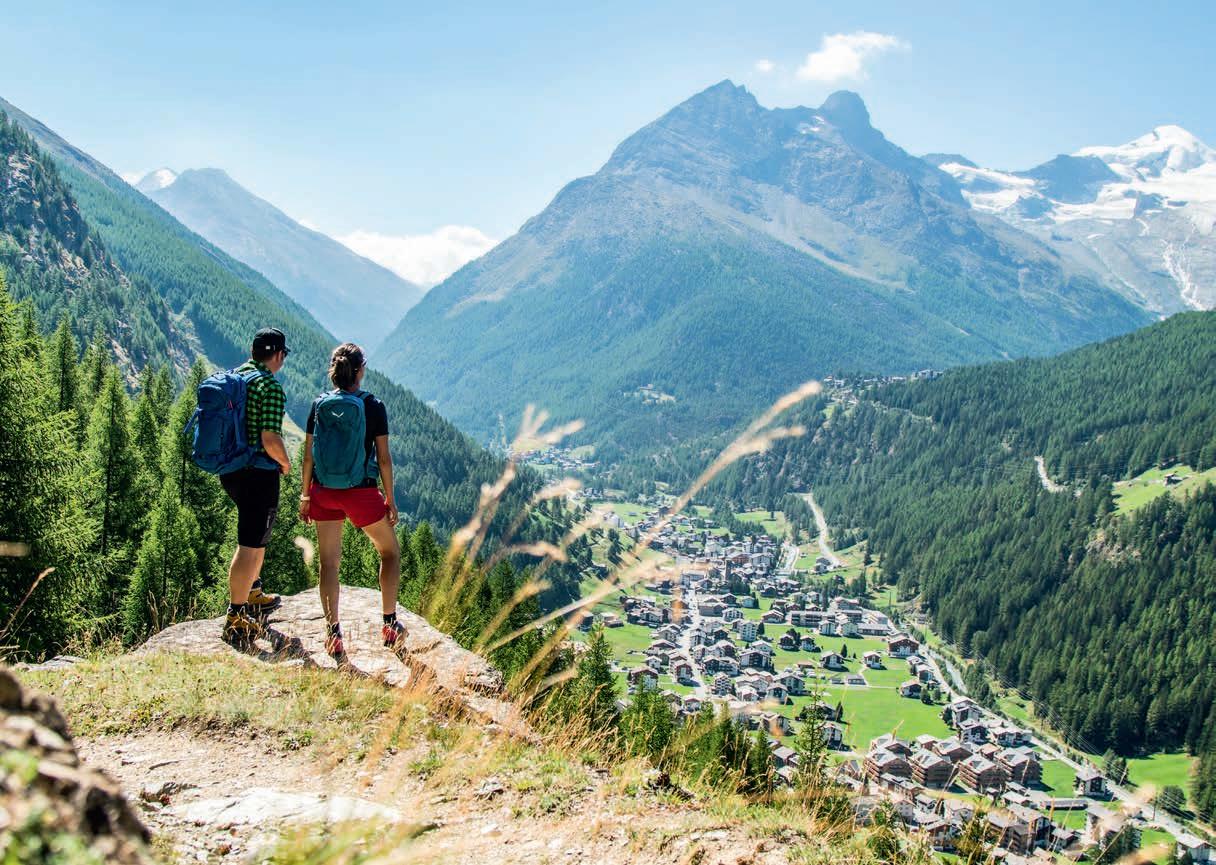
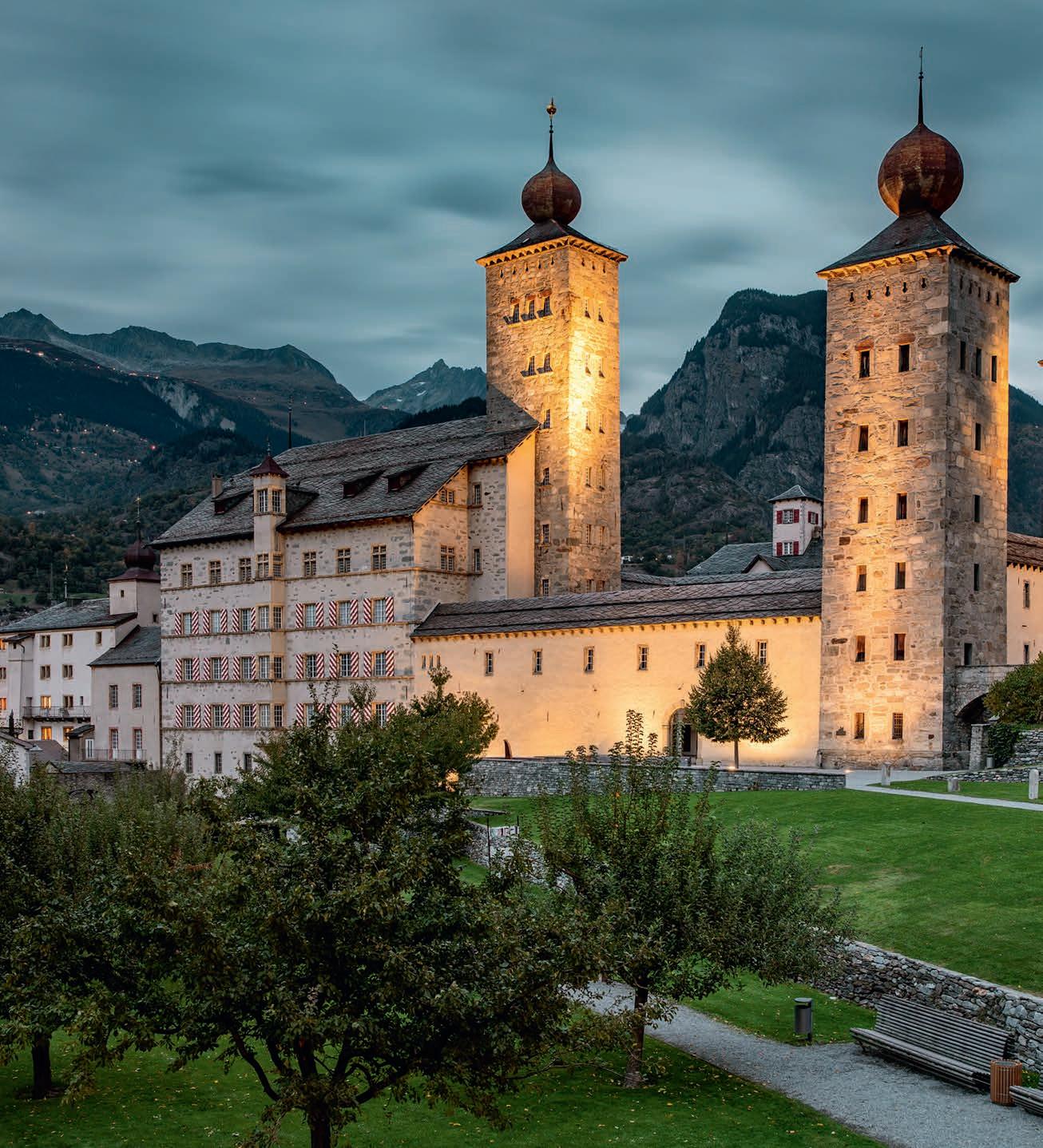
©Valais/Wallis Promotion - Jan Geerk; ©Valais/Wallis Promotion - David Carlier
Beautiful Brig
A visit to the Stockalper Palace in Brig not only allows you to admire the fine architecture, but reveals the life of the man who had it built, Kaspar Stockalper. The trader made a fortune selling everything from salt to slugs and his palace was the biggest to be built in the 17th century; the Assiette valaisanne, or Valais platter, is a spread of rye bread, local cheeses and dried meats which has been awarded an Indication of Geographic Protection
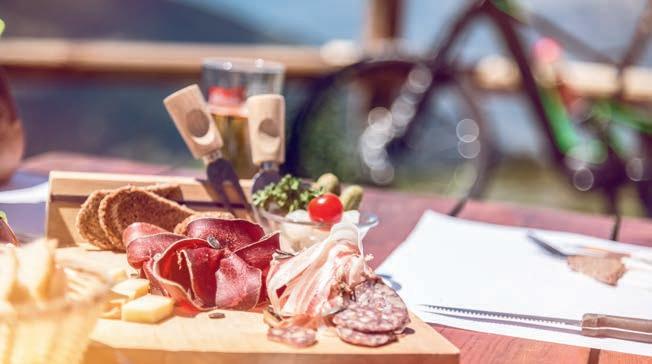
ESSENTIAL INFORMATION How to get there and around:
The Valais is accessible by direct train from Geneva and Zurich airports. Swiss national railways links to regional trains including the Mont Blanc Express from Martigny and the Matterhorn Gotthard Bahn from Brig to Zermatt, as well as to the PostBus network serving mountain villages. When to go: Cabins and hiking trails are open from mid-June to the end of October. July and August can be hot, even at high altitude, while September and October bring cooler weather and golden colours in the trees. To book the Valais experience, go to: visitvalais.ch/shop
INDULGE YOUR CULTURAL APPETITE
The appeal of the Valais doesn’t only lie in its natural attributes; the region is packed with cultural and gastronomic attractions, too. In the lively town of Brig for example – whose cobbled Old Town thrives with restaurants and bars – is the Stockalper Palace, its ‘onion’topped towers visible throughout the town. Built by Kaspar Stockalper, a wealthy 17th century entrepreneur and merchant, the castle museum and gardens are worth a visit, while the courtyard hosts open-air cinemas in summer.
While in the Rhone Valley, take time to sample local produce from its vineyards, orchards and farms. Join a wine discovery tour in the regional capital, Sion, to learn why the Valais is the largest wine-growing area in Switzerland, before sampling five typical wines of the region. Wine pairs perfectly with the area’s trademark dish, the Assiette valaisanne (Valais platter), a spread of rye bread, local cheeses and dried meats which is served both in city restaurants and at mountain huts along hiking routes, where the produce on the platter is locally sourced and has been awarded an Indication of Geographic Protection.
Alternatively, compile a picnic of all that delicious fresh local food to take with you on a hike. History buffs will enjoy the Gemmi Pass, a historic hiking route that has existed since the 15th century. The path will take you from Leukerbad to Kandersteg which featured on the first organised tour of Switzerland in 1863, arranged by the famous British tour company founder, Thomas Cook.
Once back in the village, refuel with a well-deserved Raclette du Valais AOP. The hearty melting cheese is produced in the canton and has had a protected designation of origin since 2007, and is bound to leave you with a lasting taste of this incredible part of Switzerland.
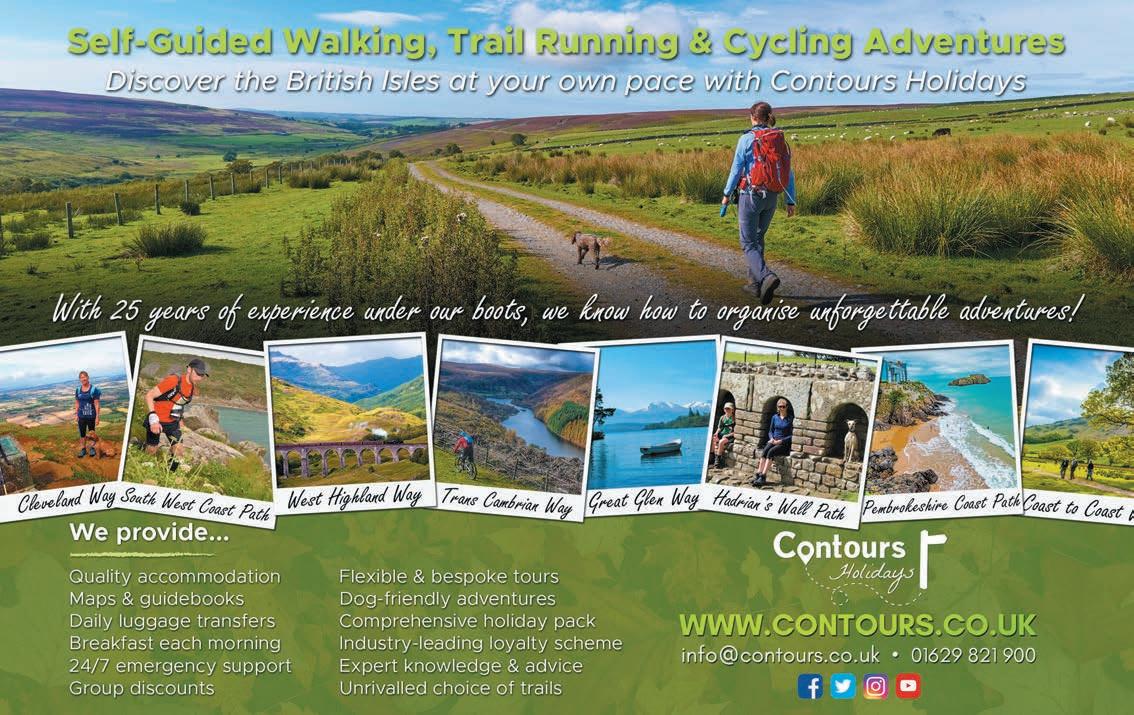
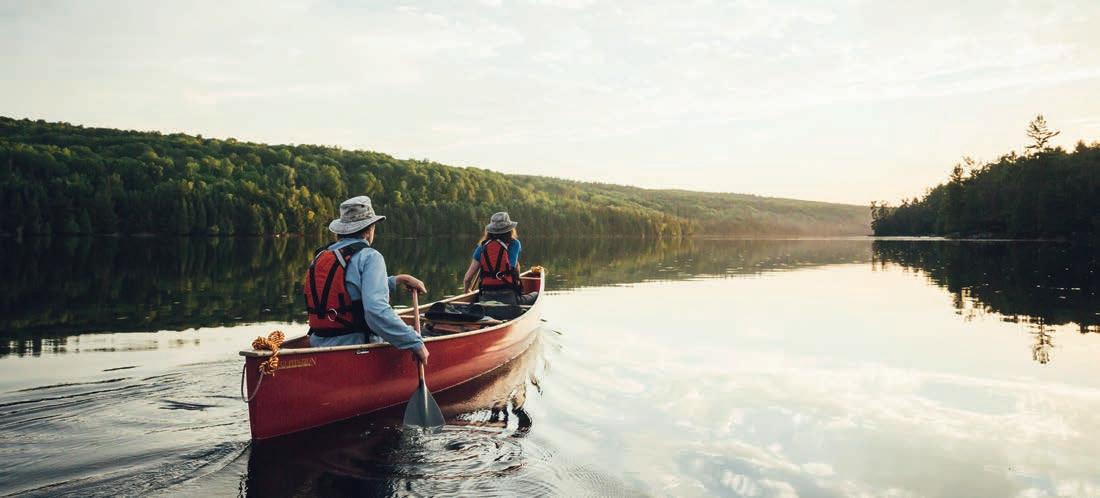



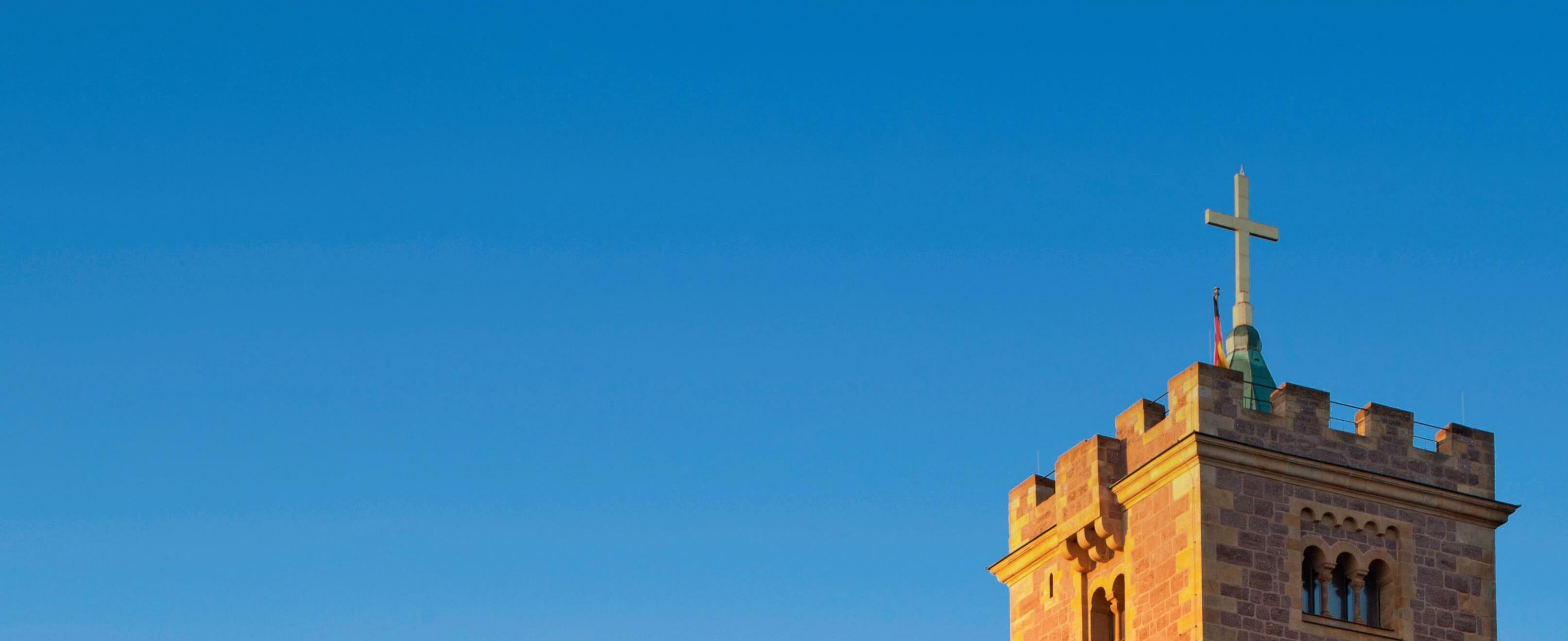

discover discover
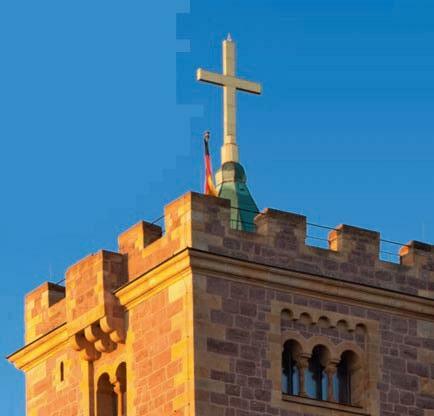
New York State’s hidden wine country, Bolivia's New York State’s hidden wine country, Bolivia's original capital, and recovering Namibia’s lost capital, and recovering Namibia’s lost traditions – we investigate the places and traditions – we investigate the places and happenings you need to know about… happenings you need to know about…

Double bill: Rennes & Nantes 168 Hidden USA: The Finger Lakes, NY 170 Indigenous cultures: Namibia 174 Heritage: Colonia del Sacramento 176 British break: Pembrokeshire 180 Off-grid: Sucre, Bolivia 184 Short break: Thuringia, Germany 188 View from above: Guanajuato 194

